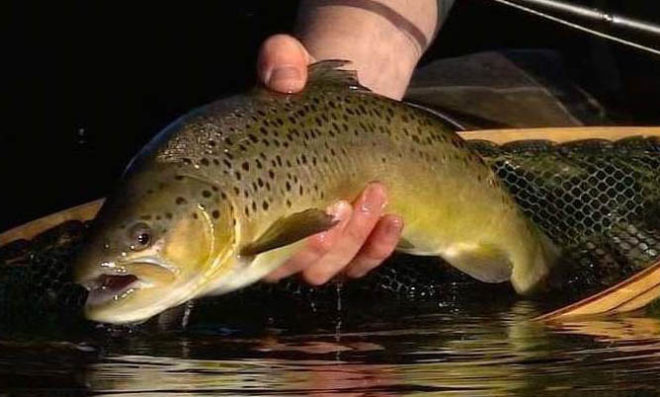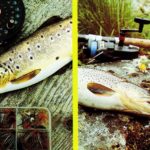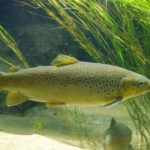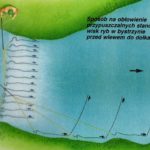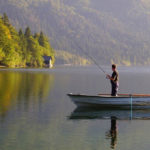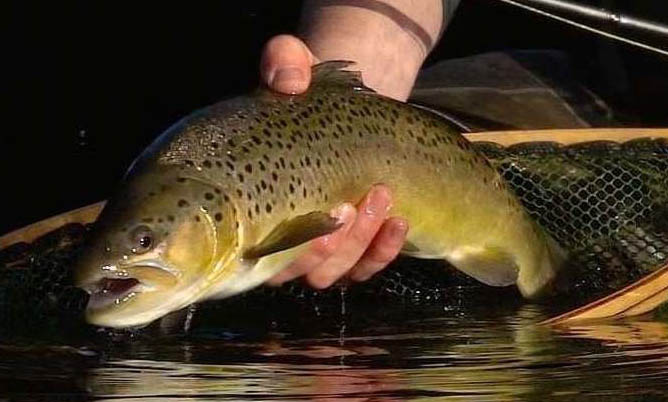 Duży pstrąg na sztucznej przynęcie spinningowej. Aby do tego doszło, istotny jest rodzaj oraz sposób prowadzenia.
Duży pstrąg na sztucznej przynęcie spinningowej. Aby do tego doszło, istotny jest rodzaj oraz sposób prowadzenia.
Pstrąg potokowy i tęczowy są w gruncie rzeczy drapieżnikami. W wodach górskich większość pokarmu pstrągów stanowią owady i strzeble. W krainie lipienia i „niżej” pstrągi nie gardzą również innymi rybami, żabami oraz innymi kręgowcami. Pstrągi pożerają także własne potomstwo (kanibalizm). Nic dziwnego, że połów spinningiem na sztuczne przynęty daje dobre wyniki. Naszą zdobyczą stają się wtedy duże kropkowane drapieżniki. Najlepszym okresem do spinningowania jest wiosna, zaraz po okresie ochronnym pstrąga. W Polsce okres ochronny pstrągów potokowych kończy się 31 stycznia. Pstrągi potokowe wędrują w celu odbycia tarła do wyżej położonych partii rzek i strumieni. Pozostają tam jeszcze pewien czas i uprawiają kanibalizmem. Wyrządzają przy tym wiele szkód we własnej populacji, jeżeli nie zostaną w porę wyłowione. Doświadczonemu wędkarzowi znalezienie miejsc połowu nie nastręcza dużego kłopotu. Ulubionymi stanowiskami pstrągów są zagłębienia i rowy wodne, spiętrzona, spokojna woda za tamami, okolice głazów, podmyte brzegi, sięgające do wody korzenie drzew i inne kryjówki.
SPROWOKOWAĆ PSTRĄGA
W zimnej i klarownej wodzie nie mamy dużych szans na odniesienie sukcesu. Pstrągi stoją wtedy w swoich kryjówkach nieruchomo i nie wykazują zainteresowania proponowaną przez wędkarza przynętą. Tym bardziej, że sam wędkarz schodzący w dół rzeki jest doskonale widoczny dla pstrągów. Wraz ze wzrostem temperatury oraz opadami deszczu powodującymi często mętnienie wód w strumieniach, budzi się życie. W okresie tym pstrągi są nieco ociężałe i szybka pogoń za przynętą nie jest ich mocną stroną. Zmęczone po odbytym tarle muszą oszczędzać siły. Dlatego też tylko powolnie prowadzenie błystki pod prąd może sprowokować pstrąga do ataku. Prowokowanie jest rzeczywiście odpowiednim słowem, gdyż nieraz trzeba parę razy poprowadzić przynętę tuż przed nosem ryby, zanim nastąpi pobicie. Prawdopodobnie pstrąg przypuszcza, że jest to ławica przepływających rybek i dopiero po pewnym czasie decyduje się, aby na nie „zapolować”. Czasem osiąga się dobre rezultaty poprzez parokrotne poruszanie przynętą w okolicy stanowiska pstrąga, imitując przy tym ucieczkę. Żeby nie utracić apetycznego kąska, pstrąg łapie podaną przynętę. W każdym przypadku powinno się dobre miejsca dokładnie „obłowić”. Im mniejszy zbiornik, tym trudniej jest łowić przy użyciu błystki. Często tylko na odcinku 1-2 m przynęta znajduje się w polu widzenia ryby. Dokładna obserwacja nurtu oraz celne rzuty decydują o braniu. Stosuje się tu najczęściej rzuty z nadgarstka lub tak zwane strzałowe, wykorzystując sprężystość wędziska. Optymalne wędziska pstrągowe powinny być długości 2,10-2,40 m oraz o ciężarze rzutowym 2-15 g. Ponieważ tylko niewiele firm produkuje tak skomponowane wędki, niektórzy wędkarze przerabiają sobie wędki muchowe mające dane właściwości. Do takiej wędki pasuje lekki kołowrotek o stałej szpuli lub kapslowy z nawiniętą żyłką o średnicach od 0,22-0,25 mm. Moc żyłki powinna być wystarczająca do powstrzymania ucieczki pstrąga o masie ponad 1 kg. Zbyt cienkie żyłki powodują szybką utratę drogich błystek na zaczepach, których nie można uniknąć.
